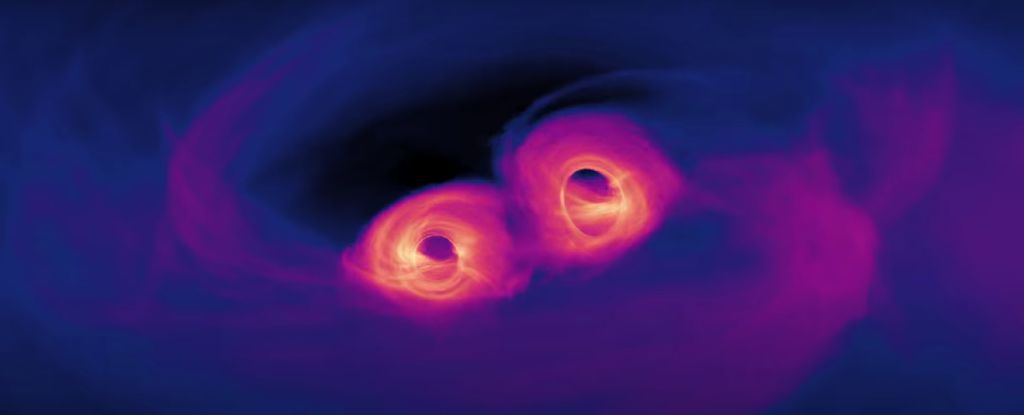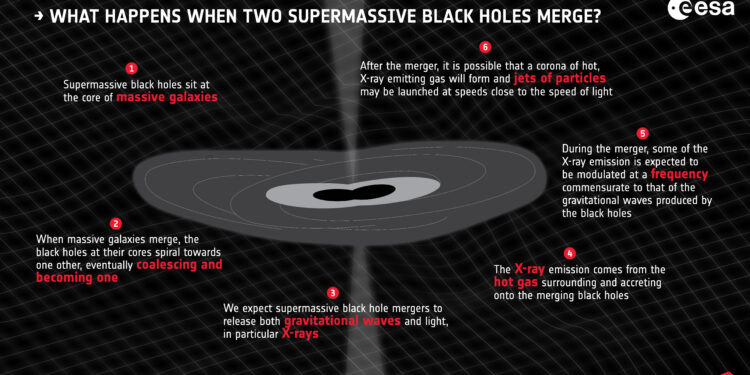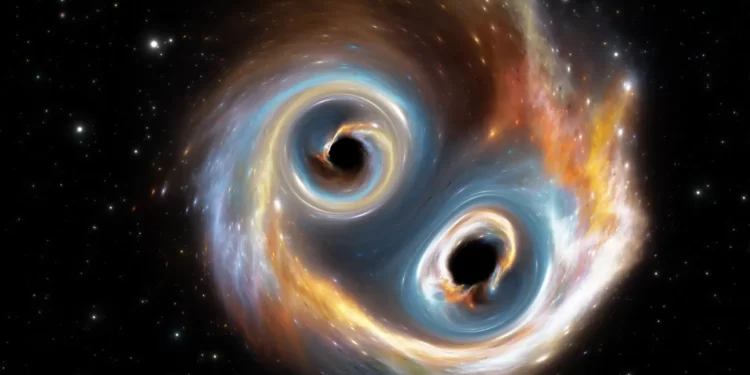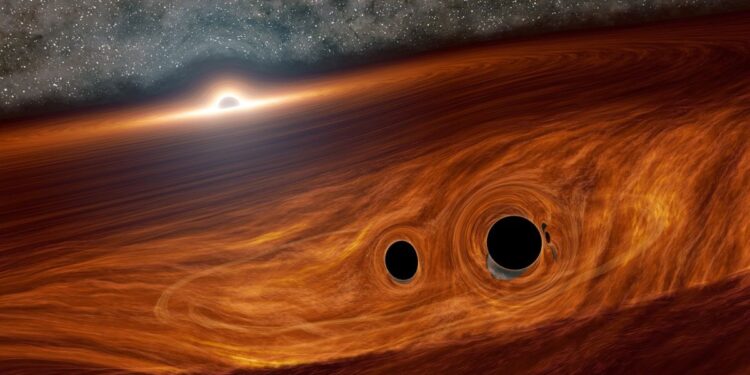Merging black holes in galaxies like the one we live in
A group of researchers from UNIGE, Northwestern University, and the University of Florida used cutting-edge simulation methods to shed light on the mysterious nature of these celestial “beasts.”

Black holes, some of the most fascinating cosmic objects, have such a powerful gravitational attraction that not even light can escape from them.
The discovery of gravitational waves in 2015, which was made possible by the merger of two black holes, provided a fresh perspective on the cosmos.
Since then, dozens of similar sightings have aroused astrophysicists’ interest in discovering their cosmic causes.
A team of researchers, including some from the University of Geneva (UNIGE), Northwestern University, and the University of Florida (UF), challenged earlier theories by predicting the existence of merging massive, 30 solar mass black hole binaries in Milky Way-like galaxies thanks to the POSYDON code’s recent significant advancements in simulating binary-star populations.
The Nature Astronomy journal has reported these findings.
Read More –
James Webb telescope found 4 oldest galaxies & Black hole |
Stellar-mass black holes are astronomical objects with masses a few to a few hundred times that of the sun that are the result of stars collapsing.
Them is very difficult to detect them because their gravitational field is so strong that neither matter nor radiation can escape them.
Therefore, it was heralded as a turning point when the Laser Interferometer Gravitational-wave Observatory (LIGO) discovered the minute jitters in spacetime caused by the merger of two black holes in 2015.
The two merging black holes at the source of the signal, according to astronomers, were 1.5 billion light-years apart and nearly 30 times as massive as the sun.

The integration of theory and observation
What processes result in these black holes? Are they the offspring of two stars that evolved in a binary system, which are identical to our sun but much more massive?
Or do they happen as a result of black holes in densely populated star clusters accidentally colliding with one another?
Or perhaps a stranger mechanism is at play? These issues are all still being passionately contested today.
Significant progress has been achieved in modeling binary-star populations by the POSYDON cooperation, a group of researchers from universities such as the University of Florida (UF), Northwestern, and the University of Geneva (UNIGE).
Read More –
Are there any rogue planets in our The Milky Way”? What do you think about Galaxy? |
This study aids in delivering more precise responses and bridging the gap between theoretical forecasts and empirical data. It is vital to rely on simulations that accurately reflect their observable characteristics because it is difficult to actually see the development of merging binary black holes.
As the primary author of this work and a post-doctoral researcher at the Department of Astronomy of the Faculty of Science at UNIGE, Simone Bavera says, “We achieve this by modelling the binary-star systems from their infancy through the development of the binary black hole systems.

Pushing Simulation’s Limits
Comparing theoretical model predictions with real observations is necessary to interpret the origins of merging binary black holes, as those seen in 2015.
The process of modeling these systems is referred to as “binary population synthesis.
“The statistical characteristics of the resulting population of gravitational-wave sources are estimated using this method, which mimics the evolution of tens of millions of binary star systems.
However, until recently, scientists have depended on models that approximatively mimic the evolution of the stars and their binary interactions in order to do this in an acceptable amount of time.
Read More 7 New Scientific Discoveries: Know everything |
Therefore, oversimplifying single and binary star physics results in less precise predictions, says Anastasios Fragkos, an assistant professor at the UNIGE Faculty of Science’s Department of Astronomy.
These constraints have been overcome by POSYDON. It was created as open-source software and uses a huge library of intricate single- and binary-star simulations that have already been calculated to forecast the evolution of isolated binary systems.
This simulation method is not directly suitable for binary population synthesis since each of these intricate simulations may take up to 100 CPU hours to conduct on a supercomputer.
However, POSYDON may use this substantial dataset in combination with machine learning techniques to forecast the whole evolution of binary systems in less than a second by precompiling a library of simulations that span the entire parameter space of beginning circumstances.
This speed is similar to that of earlier rapid population synthesis algorithms, but with better precision, says Jeffrey Andrews, an assistant professor in the physics department at the University of Florida.

A New Model Is Being Introduced
“Prior to POSYDON, models predicted a negligible formation rate of merging binary black holes in Milky Way-like galaxies, and they did not predict the existence of merging black holes as massive as 30 times the mass of our sun.”
“POSYDON has demonstrated that such massive black holes could exist in Milky Way-like galaxies,” says Vicky Kalogera, a Daniel I. Linzer Distinguished University Professor of Physics and Astronomy at Northwestern, director of the Center of Interdisciplinary Exploration and Research in Astrophysics (CIERA), and co-author of this study.
Previous models overstated key factors, such as big star growth, which affects mass loss and binary interactions.
These factors are crucial in determining the characteristics of merging black holes. POSYDON delivers more precise predictions of merging binary black hole parameters like as masses and spins thanks to completely self-consistent comprehensive stellar-structure and binary-interaction simulations.
This is the first research to examine merging binary black holes using the recently available open-source POSYDON software.
It sheds fresh light on the mechanics of merging black holes in galaxies like our own.
The research team is presently working on a new version of POSYDON that will feature a bigger library of detailed star and binary simulations that will be capable of modeling binaries in a broader variety of galaxy types.
Article Source:
Materials provided by Université de Genève. Note: Content may be edited for style and length.

















